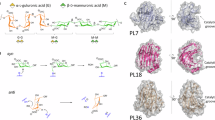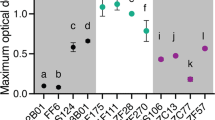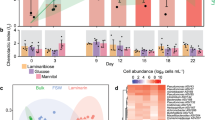Abstract
ALGINIC acid, the industrial importance of which is increasing, constitutes a large proportion of the dry weight of certain seaweeds. It is noteworthy among polysaccharides in that it appears to be built up entirely of d-mannuronic acid residues, although its resistance to hydrolysis is so great that no quantitative transformation to d-mannuronic acid has been achieved1. The results we have recently obtained from a study of the action of methyl alcoholic hydrogen chloride on the polysaccharide show that high yields of d-mannuronic acid are obtainable from alginic acid.
This is a preview of subscription content, access via your institution
Access options
Subscribe to this journal
Receive 51 print issues and online access
$199.00 per year
only $3.90 per issue
Buy this article
- Purchase on SpringerLink
- Instant access to full article PDF
Prices may be subject to local taxes which are calculated during checkout
Similar content being viewed by others
References
Nelson and Cretcher, J. Amer. Chem. Soc., 51, 1914 (1929); 54, 3409 (1932). Bird and Haas, Biochem. J., 25, 403 (1931). Schoeffel and Link, J. Biol. Chem., 100, 397 (1933).
Hudson and Maclay, J. Amer. Chem. Soc., 60, 2059 (1938).
Chemistry and Industry, 58, 363 (1939).
Author information
Authors and Affiliations
Rights and permissions
About this article
Cite this article
HIRST, E., JONES, J. & JONES, W. Structure of Alginic Acid. Nature 143, 857 (1939). https://doi.org/10.1038/143857a0
Issue date:
DOI: https://doi.org/10.1038/143857a0
This article is cited by
-
An oxidative metabolic pathway of 4-deoxy-L-erythro-5-hexoseulose uronic acid (DEHU) from alginate in an alginate-assimilating bacterium
Communications Biology (2021)
-
Über die löslichen Ultrafilter aus Aluminium- und Lanthan-Alginat und die elektronenmikroskopische Demonstration ihrer Filtrationseigenschaften
Zeitschrift für Hygiene und Infektionskrankheiten (1963)



